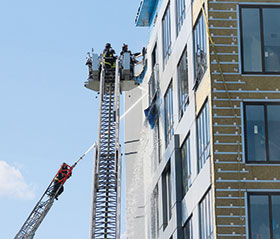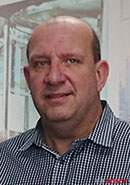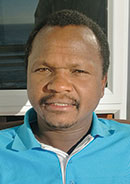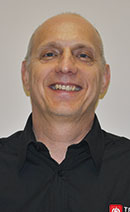

The ancient Greeks believed that fire was one the four basic elements that composed all things in the universe. What we do know is that when fire is not detected and suppressed in its early stages, the damage and devastation it can cause is incalculable, especially when loss of life is a result.
Hi-Tech Security Solutions speaks to fire specialists about adequate planning for fire risk.
Fire follows four stages – ignition, growth, fully developed, and decay (burnout). In order to ensure that a fire does not progress beyond the first stage, adequate detection and suppression technology needs to be in place.

Colin Kahn, Bosch Security Systems, says that every fire design is inherently unique and requires a consultant to identify the needs analysis of the customer and combine this with the necessary fire standards to provide the best solution. He points out that technology need not always be top of the range. Furthermore, that there are continuous advancements in fire technology, and that the solution deployed should be matched to the relevant technology in order not to over- or under-sell a solution. This is where the consultant can add the most value.
“In a nutshell, the appropriate technology simply has to ensure that the customer needs are satisfied in terms of compliance with the standards as well as any insurance requirements. Ideally, the services of a qualified fire engineer should be used, but again this depends on whether the size of the project justifies this extra cost. As a bare minimum, a person holding a relevant SAQCC-Fire qualification can be used for smaller projects,” says Kahn.

Charles Thiong’o, ACF Technologies, adds that it is critical to carefully assess the fire risks before deciding on technology. Factors for implementing a fire detection and suppression system include whether a fire event has occurred previously; what specifications the insurance company has documented as necessary; and whether the system is being deployed as an occupational health and safety compliance project.
He says that the mistake made by most companies is not using an appropriately registered and experienced designer. “The temptation for most companies is to choose the cheapest fire system they can find, but since design solutions are based on previous experience, coupled with exact application requirements, one needs to choose a fire system carefully.”
Rational design
Niel Jordaan, Sperosens, says that when conducting a fire risk assessment based on life safety and asset protection, one needs to use both the National Building Codes and international standards to produce a rational design methodology. This rational design should be signed off by the local fire chief or the chief firefighter of a facility.
Thiong’o points out that if a system installer deploys the system as per the designer’s design, then the designer takes responsibility for the solution and this liability does not end with the installation, unless the building structure and layout changes at some future date.
Kahn says that with respect to installations, again, an SAQCC-Fire qualification should be a prerequisite. He cautions that there are different levels of SAQCC-Fire certified proficiencies from cabler, installer, commissioner/serviceman to designer, so clients should ensure that they are employing the correct person for the project.
Jordaan says that although in commercial buildings, fire protection is implemented according to the National Building Codes, there may be some special risks which are not addressed by these codes. The default is to then refer to internationally accepted standards. In some instances, there will also be client-specific fire standards which will call for a combination of both local and international codes. In all instances, there are fire consultants and fire engineers who can advise on the correct route to follow.

Brett Birch of Technoswitch says that fire design is a very broad field but common factors would be to save lives, for business continuity and for asset protection. As far as fire detection is concerned, certain SANS regulations come into play. These include SANS 10400: Part T which prescribes regulatory standards for fire detection in terms of the National Building Regulations.
However, he points out, documented regulatory requirements may not meet specific end-user requirements in terms of fire safety, if that risk is not covered under the standard. It is therefore critical for the end user to clearly identify what they want from a system.
Some of the main issues they would address in terms of the purpose of the fire detection system would be to: protect life solely, such as in hospitals and old age homes; to protect property or a specific risk area in a building, such as business processes; or to maintain business continuity after a fire. In most instances, there would be a combination of these, with more emphasis on one of the elements.
Furthermore, says Birch, registered consultants or fire system designers are held accountable for the designs they produce and are responsible for specifying the category of system they are designing to, for example L1, P1. The end user can check the chosen design category against SANS 10139:12 Annex A which outlines the choice of appropriate category of fire detection and alarm system for various types of premises.
The right fit
So you have a fire plan in place, but how do you go about selecting the correct technology for the project? With the abundance of fire detection equipment on the market, there are certain non-negotiables that need to be addressed.
Firstly, can the product be sourced locally? Can the product be serviced by more than one service provider? Thiong’o says that the issue with having only one service provider is that the customer can be held to ransom by the service provider. Finally, one needs to assess whether products are readily serviceable by contractors who are, if possible, FDIA approved, due to the fact that the FDIA has a strong code of ethics.
‘You get what you pay for’ is Kahn’s opinion. “Branded systems with a proven track record not only reduce the incidences of false alarms, but have the necessary warranties, backup and support, and local stockholding. I would encourage customers to request references to see first-hand where the solutions have worked well.”
Sadly, says Jordaan, there is no specific resource that allows customers to check the compliance or validity of products. He suggests undertaking a peer review via installers, fire engineers and integrators to determine best fit, applicability and compliance with standards.
Birch is of the opinion that end users should ask specific questions to ascertain whether products are up to scratch. In terms of fire detection equipment, SANS10139 clearly recommends the use of equipment that has been approved and third-party certified to the relevant product standards, such as SANS50054 Part 2 and 4 for fire control panels, or SANS50054 Part 7 for optical smoke detectors, for example. In addition, end-users should also focus on equipment warranties and the provision of local backup and support.
System cooperation
One of the burning questions companies need to ask, given the trend towards integration, is whether today’s fire safety solutions are based on open standards that will allow them to be managed from a central management platform. Examples here could include the integration of fire detection systems with an overall Building Management System (BMS) that has the ability to cross-pollinate data from HVAC, security, fire and other complementary systems.
Most fire systems can be interfaced with a BMS. Recommendations on system compatibility can be garnered from both the designer and the installer. It is important to include both stakeholders in the process since the designer undertakes a general overview of the required standards and the installer completes the final link ups together with a commissioning engineer.
According to Birch, most systems now have a gateway that will convert the fire system’s proprietary protocol to a more open protocol such as Modbus or BACNet. Software management suites are generally built in to write cause and effect strategies, as well as data logging and calendars, and would have IP capabilities to allow for remote BMS access and even programming.
Jordaan says that although current technology does allow for this integration, especially for large commercial buildings, it is presently underutilised and needs to become an integral part of any fire system plan.
What’s hot?
Thiong’o says that technology in the fire detection market is constantly evolving and improving. The choice of, for example, a beam or aspirating system essentially comes down to the application requirements. In addition, a careful review of suppliers who have various products for each application should include an assessment of the benefits and limitations of each model and whether they work well with other systems. He stresses that fire standards need to be taken more seriously, as it is unthinkable that an event akin to the recent London fire disaster should occur due to non-compliance.
According to Kahn, there is a trend towards the digitalisation of fire safety. IP communications is now more readily accepted and aspiration technology has increased in popularity. “Unfortunately, although technology is rapidly growing, the standards are not keeping pace with the technology. There therefore needs to be a closer relationship between the standards authority and the fire detection associations, with testing and implementation occurring a lot faster than it currently is.”
Jordaan says that water mist is becoming more readily accepted in fire-fighting technology. While this is a relatively new technology, it has been widely accepted in the US and Europe, with awareness increasing in South Africa.
Birch feels that technology suppliers should be addressing the challenges of reducing false alarms and providing the correct servicing and maintenance of these systems. There is a lot of effort going into these areas with false alarm management offerings focusing on alarm verification to ascertain alarm validity as well as investigation delays that provide time for onsite personnel to verify if it is a valid alarm.
With regard to maintenance and servicing Birch says that the SANS standards are very specific, stipulating that a fire detection system needs to be serviced regularly to ensure it is fully operational at all times. He says that companies are working towards streamlining and providing a means of monitoring fire alarm systems. These include investments in cloud-based services to log and provide administrative testing of fire alarm systems. These systems will allow end-users to maintain an electronic log of fire systems over their lifetime. This not only benefits the end-user by providing reliability and system uptime, but benefits suppliers because they can offer this as a value added service.
All interviewees agree that ignorance is not bliss. Customers need to look for a designer/engineer/installer that has SAQCC-Fire qualifications and is preferably FDIA-approved. Knowledge of local standards and the risks involved is mandatory. A thorough knowledge of the National Building Codes as well as international fire standards is also a prerequisite. Finally, where possible, ask stakeholders to provide reference sites in order to ensure that the solution you deploy is tried and tested in the market.
For more information, contact:
• ACF Technologies, +27 (0)11 452 2911, [email protected], www.firesensor.co.za.
• Bosch Security Systems – South Africa & sub-Saharan Africa, +27 (0)11 651 9600, [email protected], http://africa.boschsecurity.com
• Sperosens, 086 177 3767, [email protected], www.spero.co.za
• Technoswitch, +27 (0)11 794 9144, [email protected], www.technoswitch.co.za
| Tel: | +27 11 794 9144 |
| Email: | [email protected] |
| www: | www.technoswitch.co.za |
| Articles: | More information and articles about Technoswitch Fire Detection & Suppression |
| Tel: | +27 11 452 2911 |
| Email: | [email protected] |
| www: | www.acftech.co.za |
| Articles: | More information and articles about ACF Technologies |
| Tel: | +27 11 651 9600 |
| Email: | [email protected] |
| www: | www.boschsecurity.com/xf/en |
| Articles: | More information and articles about Bosch Building Technologies |
| Tel: | +27 12 665 0317 |
| Email: | [email protected] |
| www: | www.spero.co.za |
| Articles: | More information and articles about Spero Sensors & Instruments |

© Technews Publishing (Pty) Ltd. | All Rights Reserved.